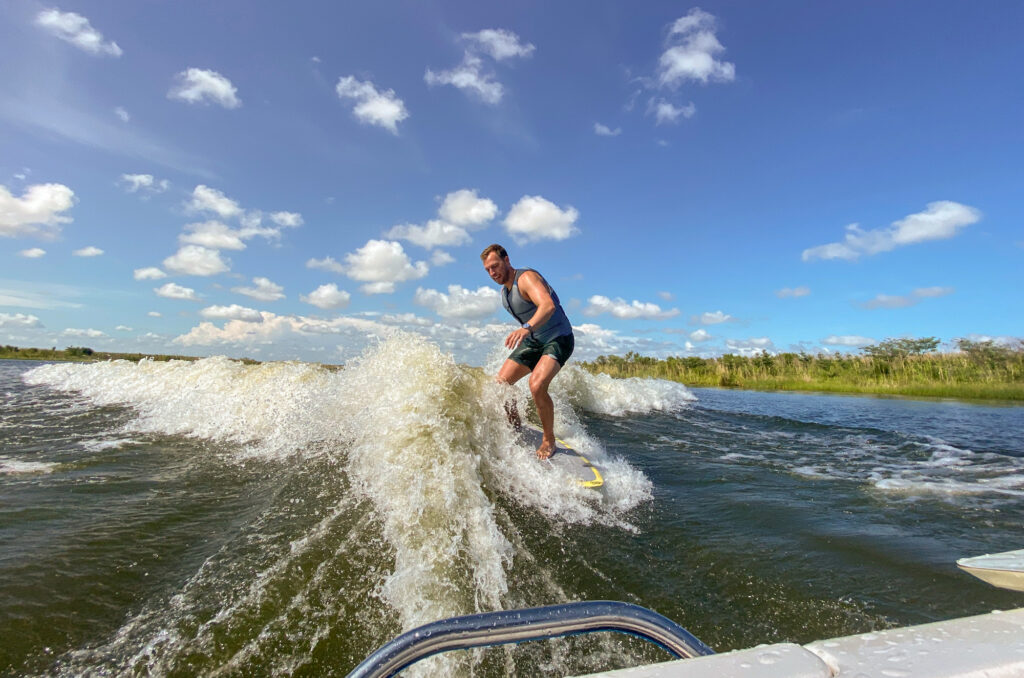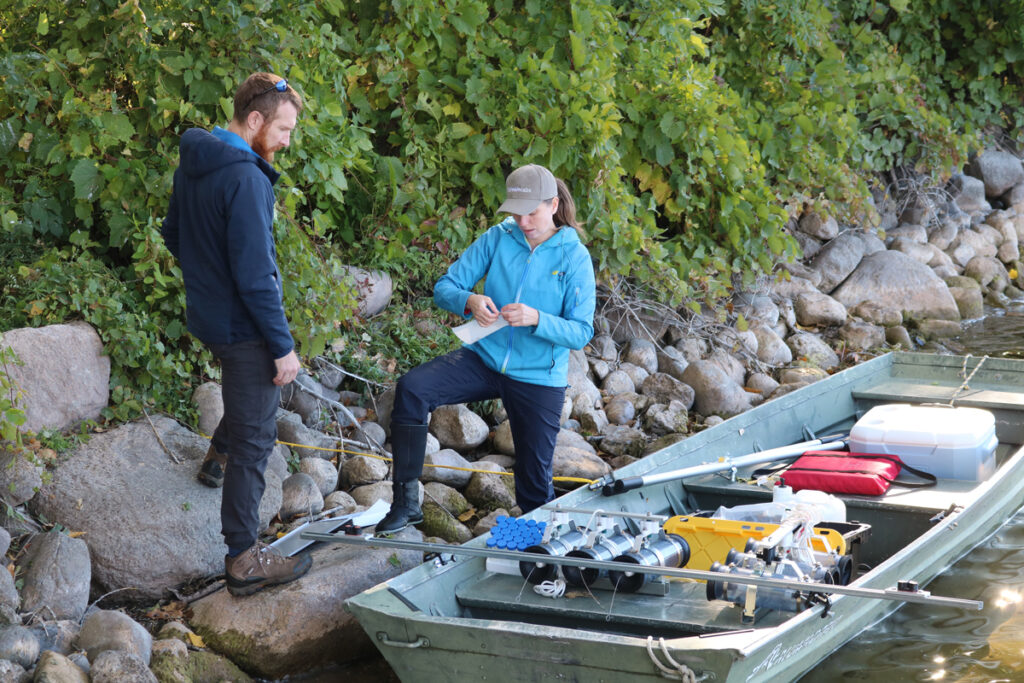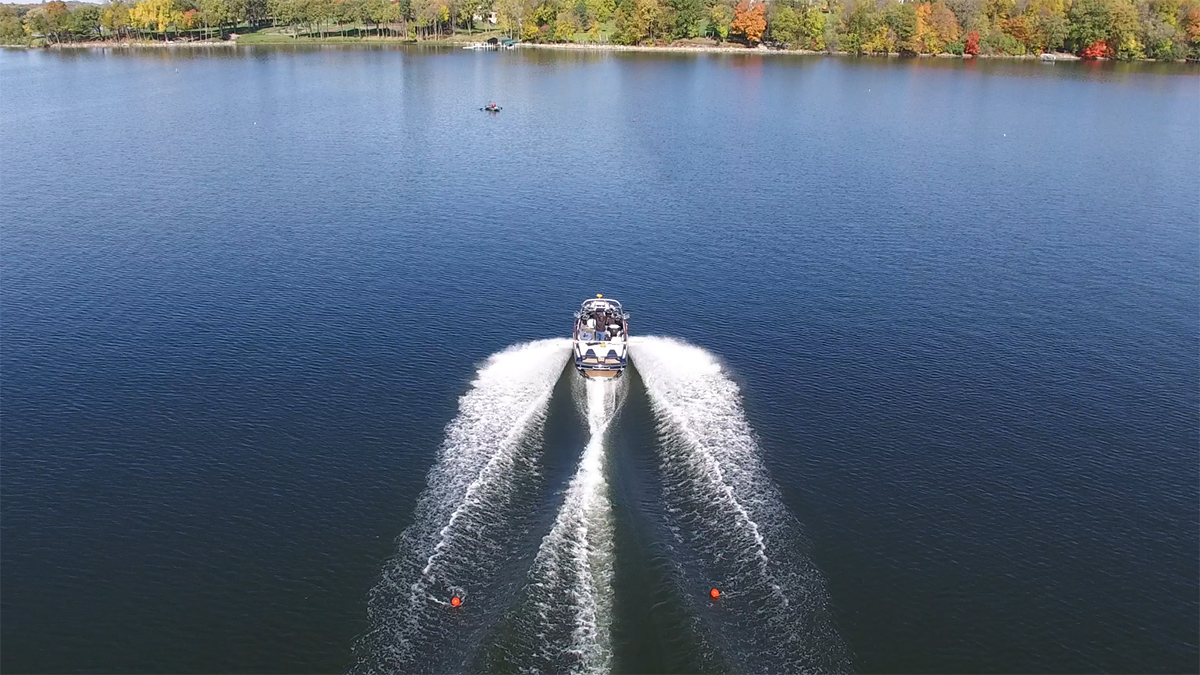Wakeboats are causing a stir in Minnesota.
Though all powerboats create wakes, these specialty craft have heavier sterns and engines specifically designed to shape water into surfable waves. That extra turbulence is drawing ire from other lake-lovers.
Across the state, Minnesotans are reporting eroding banks, murky waters, and shredded vegetation. When considering wakeboats, one person’s recreation is another’s resentment.
“It’s divisive,” said Joe Shneider, president of the Minnesota Coalition of Lake Associations. “The three big issues we hear all the time [about wakeboats] are personal safety, bank erosion, and lake bed disruption.”

As the popularity and size of wakeboats grow, so does the need for data. Communities are wrestling with issues of regulation and education, and both approaches require information. That’s why Shneider and more than 200 others helped crowdfund recent research from the University of Minnesota’s Saint Anthony Falls Laboratory. (The state also supported the project.) The resulting public dataset shows how wakeboats can churn lake beds, information that can help communities navigate the brewing conflict.
The Stakes
Minnesota is not the only state navigating a great wake debate. In 2024, Maine implemented wakeboat regulations and Vermont restricted wake surfing to its 30 largest lakes. (Some residents want the number further reduced to 20.) In Wisconsin, individual municipalities are debating bans on wake surfing at hundreds of lakes, prompting at least one lawsuit.
Minnesota, in contrast, has issued wakeboat regulations at only one of its 10,000 lakes.
“There’s a whole lot of people out there that need to make decisions about their lake.”
The environmental issues at stake arise in shallow water, where powerboats can stir up obvious trails of sediment. Resuspended sediment absorbs sunlight, which heats the water column. Turbidity reduces the feeding rates of some fishes. Once-buried nutrients again become available, triggering toxic algal blooms that choke beaches and rob fish of oxygen.
But to connect the dots between wakeboat use and ecosystem disruption, researchers needed to document how various powerboats affect sediment dispersal.
“We want to understand how boats are interacting with the water column and provide data, because there’s a whole lot of people out there that need to make decisions about their lake,” said Jeff Marr, a hydraulic engineer at the University of Minnesota and a coauthor of the study.
The Wake
On Lake Minnetonka, just west of Minneapolis, seven locals lent their boats for the research. These watercraft ranged from relatively light, low-power deck boats (150-horsepower, 2,715 pounds) to burly bowriders (760-horsepower, 14,530 pounds) and included two boats built for wake surfing.
On test days, volunteers piloted their boats between buoy-marked goalposts. Acoustic sensors on the lake bed tracked pressure changes in the water column.
Powerboats mostly operate at either displacement speed (chugging low in the water) or planing speed (skipping faster along the surface). But there’s a transition called semidisplacement, in which the stern sinks in the water and waves spike in size.
“It’s right at that transition that [wakeboats] like to operate,” said Andy Riesgraf, an aquatic biologist at the University of Minnesota and a coauthor of the study.
Boaters drove the course five times at planing speed (21–25 miles per hour, common for water-skiing and tubing) and five times at displacement or semidisplacement mode (7–11 miles per hour, common for cruising and wake surfing). Researchers in rowboats paddled to collect water samples at various intervals in the track.

The acoustic sensors showed that three types of waves affected the water column. Pressure waves, created by the immediate shift and rebound of water around a boat, were short-lived but strong enough to shake loose sediments. Transverse waves, which follow the boat’s path, and propeller wash, the frothy vortex generated by its engines, both elevated loose sediment and caused minutes-long disturbances.
Though all boats created these waves, the wakeboats churned the most sediment.
In planing mode, all seven boats caused brief and minimal disturbances. Sediments settled in less than 10 seconds at 9- and 14-foot depths. But when operating in slower, semidisplacement mode, wakeboats created a distinct disturbance. Following a pass from a wakeboat, sediment needed 8 minutes to settle at 14-foot depth and more than 15 minutes at 9-foot depth.
The research team released simple recommendations based on their findings. One recommendation is that all recreational powerboats should operate in at least 10 feet of water to minimize disturbances. Another is that wakeboats, when used for surfing, need 20 feet of water to avoid stirring up sediments and altering the ecosystem.
The Uptake
The new research adds to the group’s existing dataset on powerboats’ hydrologic impacts on lake surfaces.
Whether the suggestions lead to regulations is up to lake managers.
“Our goal is just to get the data out,” Marr said. The researchers published their findings in the University of Minnesota’s open-access digital library so that everyday lake-goers can find the information. Three external experts reviewed the material.
The more we continue to collect these data, the more that we start to fill in those other gaps.
The results add information to the policy debate. “If there is going to be some type of environmental regulation [on powerboating], you need very clear evidence that under these conditions, it’s detrimental,” said Chris Houser, a coastal geomorphologist at the University of Waterloo who was not involved in the project.
There are other variables to study—such as the number of boats on the water and the paths they’re carving—but “the more we continue to collect this data, the more we start to fill in those other gaps of different depths and different configurations,” Houser said.
For Shneider, the new data add much-needed clarity. The latest report “is monumental,” he said.
Marr, Riesgraf, and their colleagues are now comparing the impacts of boat-generated wakes against wind-driven waves. Those data could further isolate the impacts powerboats have on lakes.
—J. Besl (@J_Besl, @jbesl.bsky.social), Science Writer
This news article is included in our ENGAGE resource for educators seeking science news for their classroom lessons. Browse all ENGAGE articles, and share with your fellow educators how you integrated the article into an activity in the comments section below.




